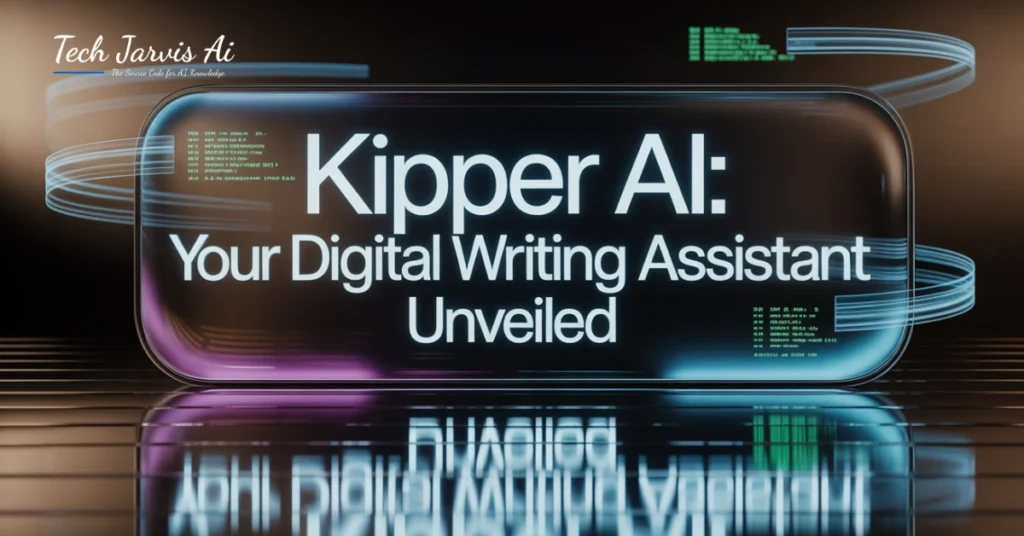Writing can feel like pushing a boulder uphill sometimes. What if there were a tool that worked like a rope and pulley—lifting much of the load, while letting you steer the direction? That’s what Kipper AI promises to be: an assistant, not a replacement. In this article, I’ll walk you through everything about Kipper AI—what it is, how it works, when it helps (and when it might hinder), and how to make the most of it without losing your voice.
What Is Kipper AI?

At its heart, Kipper AI is a digital writing assistant that combines multiple tools in one place. It offers:
An essay generator — get a draft by entering a topic.
A built-in AI detector — to assess whether a piece of writing looks “machine made.”
A summarizer — to shrink long texts into bite-size versions.
A text enhancer / humanizer — to smooth grammar, adjust style, and try to make output sound more natural.
A citation finder / reference helper — to help you locate sources or footnotes.
Read More: Janitor AI: 5 Secrets Behind Its Viral Popularity
In short: Kipper AI aims to be an all-in-one writing toolkit for students, bloggers, or anyone who needs help shaping their words.
Core Features & Tools
Let’s dig deeper into Kipper’s toolkit, breaking each feature down in simple terms so you can see what’s useful—and what to use with caution.
Essay Generation / Drafting
You feed it a topic or prompt, and Kipper produces a draft. You’ll often get a well-structured essay with an introduction, body, and conclusion. It’s great when you’re stuck with a blank page.
But be cautious: the logical flow can sometimes be weak or repetitive. Many users report needing to reorganize or rewrite parts.
Summarizer
Paste long content (e.g. research, articles) and Kipper gives you the short version. This helps when you need the gist quickly.
However, nuances or subtle arguments may get lost, so always check against the full text.
AI Detector / Humanizer
Kipper claims to detect AI-written text and “humanize” your writing so it seems more natural or less machine-like.
This is a tricky balancing act: detection algorithms are always evolving, and claims of “undetectable” often lead to risk. Some users say Kipper works well in many cases; others say it can still be flagged.
Grammar & Style Enhancer
Even if the draft is okay, style and grammar may need polishing. The enhancer helps with clarity, phrasing, and small errors. But it’s not perfect—sometimes its suggestions feel awkward or unnatural.
Citation / Reference Helper
Need to back up your claims? Kipper provides citation suggestions or helps you place references in common formats.
But be careful: the sources it suggests might require verification. Don’t blindly accept references without checking them yourself.
How It Works: Under the Hood

We don’t have Kipper’s full secret sauce, but we can infer based on how similar tools operate.
It likely uses large language models (LLMs)—the same kind of tech behind ChatGPT or GPT-4. These models are trained on huge amounts of text data, which let them predict what comes next in a sentence, or generate coherent text from a prompt.
For detection, it probably analyzes patterns, word choices, sentence structure, and markers that tend to show up in AI-generated text. Then it gives a score or flags suspicious parts.
For humanization, it may rephrase sentences, introduce variation in tone and structure, swap out overused words, and intentionally insert “imperfections” to seem more human.
The summarizer likely relies on abstractive summarization techniques: instead of just cutting lines, it rephrases the core ideas in fewer words.
Because Kipper combines these features in one interface, you don’t need multiple tools. But the tradeoff is that none of them may be perfect—they’re compromises in a convenient package.
Pros: What Kipper AI Does Well
Let me be clear: Kipper AI does bring real value in many contexts. Here are the strengths:
Saves Time on First Drafts
When you’re stuck, the essay generator gives you a skeleton to build on. It’s much faster than writing every sentence from scratch.Combines Multiple Tools Under One Roof
Instead of using separate summarizers, grammar checkers, and detectors, you get them all in one place.Easy to Use / Beginner Friendly
You don’t need coding or technical skills. Input your prompt, click a button, and get output.Good for Brainstorming
If you’re not sure how to begin, it can give you ideas or structure to start with.Affordable Entry Point
Many users say Kipper is relatively cheap compared to some high-end AI writing tools.Continuous Improvement
Because Kipper is relatively new, it gets updates, meaning features can improve over time.
Limitations & Risks
No tool is perfect, and Kipper AI has some real caveats you should know.
Inconsistent Quality & Coherence
Sometimes, the generated text has gaps in logic, repetition, or odd transitions. You may find yourself editing heavily.
Detection & Plagiarism Vulnerability
Though Kipper claims to be “undetectable,” that’s a bold claim. AI detection tools evolve too, and what flies today may not tomorrow. Some users say the content still gets flagged.
Also, the content may inadvertently mirror existing sources—always double-check with a plagiarism tool.
Subscription & Cancellation Issues
Several users have complained that canceling a Kipper subscription is harder than signing up. The cancellation link may not arrive easily, requiring contacting support.
Overreliance & Skill Erosion
If you lean too heavily on Kipper, you might lose your own writing muscle. It’s like using a calculator for every basic math—handy, but you may forget how to do it manually.
Source Accuracy & References
The citation helper is helpful, but it can recommend weak or irrelevant sources. You’ll need to vet them yourself. Relying blindly could weaken your credibility.
Use Cases: When to Use It
Kipper AI is not a magic wand—it’s a tool. Here are scenarios where it shines (and where it’s less ideal):
When It’s Useful
Tight deadline / writing block: You need something fast to get started, then edit later.
Drafting a blog post or article: Use it for structure and then inject your personal voice.
Summarizing research papers or news articles: Get the main points quickly.
Polishing grammar or style: Use the enhancer after you write your own draft.
When to Be Cautious / Avoid
Graded academic work: The stakes are higher; errors or detection can matter.
Highly creative writing (poetry, novels): These often require nuance and personal style that AI can’t capture well.
Niche technical or highly specialized topics: The AI may hallucinate or misstate facts.
When you want your unique voice: Overusing AI output may make your writing sound generic.
Best Practices: Getting Value Ethically

Here are tips to use Kipper without turning into someone else’s ghostwriter:
Use It as a Helper, Not a Creator
Treat Kipper as a co-pilot, not the driver. Let it suggest, then you decide what stays or goes.
Always Edit & Personalize
Go through the output: check logic, fix awkward phrasing, add your own examples or stories. Make it your own.
Use AI Detection & Plagiarism Checks
Before submitting, run your work through other detectors and plagiarism tools. Don’t trust a single tool blindly.
Cite / Verify Sources
If Kipper suggests citations, verify they exist and that they truly support your point.
Avoid Overreliance
Don’t let Kipper become crutches for every assignment. Keep practicing writing on your own, too.
Stay Transparent (When Required)
If your school or publisher requires disclosure of AI use, follow the rules. Honesty goes a long way.
Pricing & Plans
Kipper offers tiers—free trial plus paid plans.
Free / trial version — limited features to test.
Pro / Premium — unlocks full features, unlimited access, etc.
Some reports say plans involve daily cost (e.g. $0.99 per day) for full access.
Cancellation may require contacting support, which some users find inconvenient.
Always check the latest pricing on their official site, as these plans often evolve.
Comparing Kipper to Alternatives
Kipper is not alone in the AI writing space. Here’s how it stacks up against a few peers:
Vs. Jasper / Writesonic / Copy.ai: These are more mature tools, often better for marketing or business writing. Kipper focuses more on essays and academic content.
Vs. Grammarly / Hemingway / ProWritingAid: Those are grammar/style tools—they polish writing but don’t generate drafts. Kipper tries to do both.
Vs. Dedicated Detection Tools (e.g. Scribbr’s AI Detector): Detection tools often have more advanced detection algorithms than Kipper’s built-in detector.
Bottom line: Alternatives might outperform Kipper in specialized areas; Kipper’s strength is convenience and combining features in one place.
Future Outlook: Where Kipper AI May Head
The field of AI writing is changing fast. Here are predictions on where Kipper might evolve:
Stronger detection & humanization: Better balancing between natural style and avoiding detection.
More domain specialization: Templates or modes for legal, medical, or technical writing.
Collaborative features: Version tracking, commenting, integration with writing platforms.
Learning from edits: AI that adapts to your editing style over time.
Better citation / research tools: Linking to real academic databases or real-time sources.
Ethical guardrails: AI that flags risky claims, hallucinations, or unsupported statements.
If Kipper stays agile and transparent, it could become a trusted assistant—not just a novelty.
Final Thoughts & Takeaways
Kipper AI is like a helpful sketch pad: it gives you outlines, ideas, and rough drafts. But just like an artist refines a sketch into a masterpiece, you must shape and polish what Kipper produces. It’s not a magic wand, but for many users—students, content creators, or casual writers—it can speed up the process, spark creativity, and reduce blank-page anxiety.
Use it wisely. Don’t trust it blindly. And always keep your own voice front and center. With those safeguards, Kipper AI can become a powerful partner in your writing journey.
Frequently Asked Questions
1. What exactly can Kipper AI do?
Kipper can generate essays, summarize texts, enhance grammar and style, detect AI-written parts, and suggest citations.
2. Is Kipper AI safe to use for academic papers?
It can help with drafts, but use caution. Always check for accuracy, avoid plagiarism, and follow your institution’s rules on AI use.
3. How accurate is Kipper’s AI detector?
It gives a score or flags content, but no detector is perfect. Use supplementary AI detectors or manual review.
4. Can I cancel Kipper’s paid plan easily?
Users report cancellation may require contacting support. Always check the cancellation policy before subscribing.
5. What are good alternatives to Kipper AI?
Jasper, Writesonic, Copy.ai, Grammarly, and Hemingway are strong alternatives depending on whether you prioritize content generation, style checking, or grammar aid.
